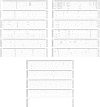Intraspecies heterogeneity of immunoglobulin alpha-chain constant region genes in rhesus macaques
- PMID: 11529934
- PMCID: PMC1783266
- DOI: 10.1046/j.1365-2567.2001.01251.x
Intraspecies heterogeneity of immunoglobulin alpha-chain constant region genes in rhesus macaques
Abstract
Immunoglobulin A (IgA) is the major antibody class present in external secretions and is also an important component of serum immunoglobulins. On mucosal surfaces, IgA represents a first line of defence by neutralizing invading pathogens. The number of IgA constant-region genes (C alpha) present in different mammalian species is variable. Immunoglobulin C alpha genes differ mainly in the sequences located in the hinge region. IgA molecules, whose hinge regions are remarkably similar to those of the respective human molecules, are present in hominoid primates. In this report, we show that two alleles of a single immunoglobulin C alpha are present in rhesus macaques (Macaca mulatta). In addition, we show that intraspecies immunoglobulin C alpha allelic polymorphism is very high in this non-human primate species. Specifically, five different hinge regions, some of which are proline-rich, were identified from a total of eight rhesus macaque immunoglobulin C alpha-chains. The five hinge regions were different from those present in hominoid primates, both in length and in sequence. These results represent the first example of high levels of intraspecies immunoglobulin constant-region variability and suggest that IgAs of variable structure and function may be present in rhesus macaques. As rhesus macaques are widely used as animal models for the development of vaccines for acquired immune deficiency syndrome (AIDS), the possible presence of structurally and functionally variable IgA molecules in different animals should be taken into account when designing experimental strategies to induce mucosal antibody responses to human immunodeficiency virus (HIV).
Figures



References
-
- Mestecky J, McGhee JR. Immunoglobulin A (IgA): molecular and cellular interactions involved in IgA biosynthesis and immune response. Adv Immunol. 1987;40:153. - PubMed
-
- Childers NK, Bruce MG, McGhee JR. Molecular mechanisms of immunoglobulin A defense. Annu Rev Microbiol. 1989;43:503. - PubMed
-
- Macpherson AJ, Gatto D, Sainsbury E, Harriman GR, Hengartner H, Zinkernagel RM. A primitive T cell-independent mechanism of intestinal mucosal IgA responses to commensal bacteria. Science. 2000;288:2222. 10.1126/science.288.5474.2222. - DOI - PubMed
-
- Nezlin R. Structure and Function. New York: Academic Press; 1998. The Immunoglobulins.
Publication types
MeSH terms
Substances
Grants and funding
LinkOut - more resources
Full Text Sources
Other Literature Sources
Research Materials
Miscellaneous

